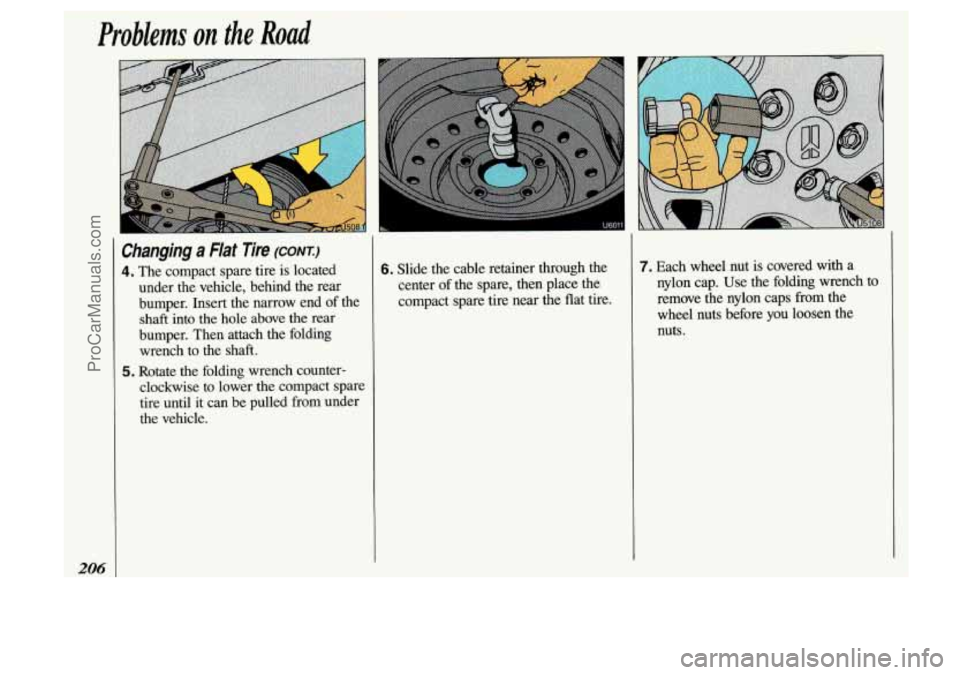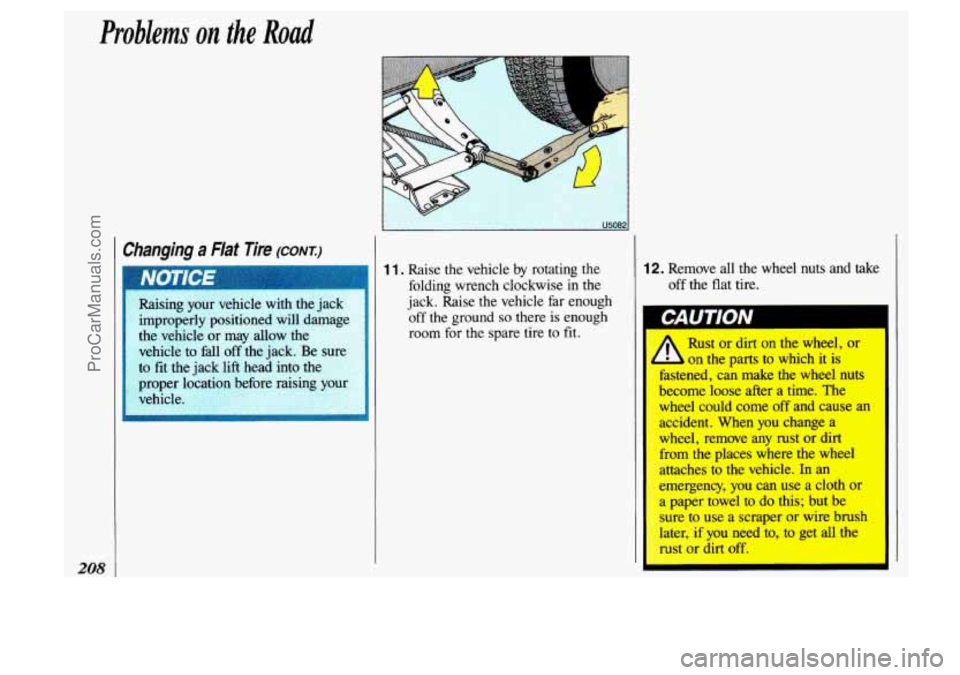1993 OLDSMOBILE SILHOUETTE lock
[x] Cancel search: lockPage 175 of 323

Torque Lock
If you are parking on a hill and you
don’t shift your transaxle into
P (Park)
properly, the weight of the vehicle may
put too much force on the parking pawl
in the transaxle. You may find it difficult
to pull the shift lever out of
P (Park).
This is called “torque lock.” To prevent
torque lock, always be sure
to shift into
P (Park) properly before you leave the
driver’s seat. To find out how, see the
Index under Shifting Into P (Park).
When you are ready to drive, move the
shift lever out of P (Park) before you
release the parking brake.
If torque lock does occur, you may need
to have another vehicle push yours a
little uphill to take some of the pressure
from the transaxle,
so you can pull the
shift lever out of
P (Park).
Winter Driving
Here are some tips for winter driving:
Have your Oldsmobile in good shape
for winter. Be sure your engine
coolant
mix is correct.
* Snow tires can help in loose snow, but
they may give you less traction on ice
than regular tires.
If you do not expect
to be driving in deep snow, but may
have to travel over ice, you may not
want
to switch to snow tires at all.
You may want to put winter
emergency supplies in your vehicle.
Include
an ice scraper, a small brush
or broom,
a supply of windshield
washer fluid, a rag,
some winter outer
clothing, a small shovel, a flashlight,
a
red cloth, and a couple of reflective
warning triangles. And,
if you will be
driving under severe conditions,
include a small bag
of sand, a piece of
old carpet or a couple of burlap bags
to help provide traction. Be sure you
properly secure these items
in your
vehicle.
173
ProCarManuals.com
Page 176 of 323

Your Driving and the Road
Driving on Snow or Ice
Most of the time, those places where
your tires meet the road probably have
good traction.
However, if there is snow or ice
between your tires and the road, you can
have a very slippery situation. You’ll
have
a lot less traction or “grip” and
will need to be very careful.
What’s the worst time for this? “Wet
ice.” Very cold snow or ice can be slick
and hard
to drive on. But wet ice can be
even more trouble because it may offer
the least traction
of all. You can get wet
ice when it’s about freezing
(32°F; 0°C)
and freezing rain begins to fd. Try to
avoid driving on wet ice until salt and
sand crews can get there. Whatever the condition-smooth ice,
packed, blowing or loose snow-drive
with caution. Accelerate gently. Try not
to break the fragile traction.
If you
accelerate too fast, the drive wheels will
spin and polish the surface under the
tires even more.
Your anti-lock brakes improve your
ability
to make a hard stop on a slippery
road. Even though you have the anti-
lock braking system, you’ll want to
begin stopping sooner
than you would
on dry pavement.
See the Index under
Anti-Lock Brake System.
Allow greater following distance on
any slippery road.
Watch for slippery spots. The road
might be fine until you
hit a spot that’s
covered with ice. On an otherwise
clear road, ice patches may appear
in
shaded areas where the sun can’t
reach: around clumps of trees, behind
buildings, or under bridges.
Sometimes the surface
of a curve or
an overpass may remain icy when the surrounding roads are clear.
If you see
a patch of ice ahead
of you, brake
before
you are on it. Try not to brake
while you’re actually on the ice, and
avoid sudden steering maneuvers.
174
ProCarManuals.com
Page 177 of 323

If You’re Caught in a Blimrd
If you are stopped by heavy snow, you
could be in a serious situation. You
should probably stay with your vehicle
unless you know for sure that you are
near help and you can hike through the
snow. Here are some things to
do to
summon help and keep yourself and
your passengers safe:
Turn on your hazard flashers.
Tie a red cloth to your vehicle to alert
police that you’ve been stopped by the
snow.
U3023
Put on extra clothing or wrap a
blanket around you. If you have
no
blankets or extra clothing, make body
insulators from newspapers, burlap
bags, rags, floor mats-anything you
can wrap around yourself or tuck
under your clothing to keep warm.
but be careful.
You can run the engine to keep warm, Snow can trap exhaust gases
under your vehicle. This ca
Lituse deadly CO (carbon
monoxide) gas to get inside.
CC
could overcome you and kill yo1
You can’t see
it or smell it, so v(
might not know it was in you
vehicle. Clear away snow from
around the base of your vehicle,
especially any that
is blocking your
exhaust pipe. And check around
again from time to time to be sure
snow doesn’t collect there.
.. -.~~-G~~:~.-~:::j~ . ., , -.> i2-j /: ,-.;-z$ Open a window just a little on-the
side
of the vehicle that’s away from
+% wind. This will help keep CO
vu t .
I
I
I
175
I
ProCarManuals.com
Page 182 of 323

Your Driving and the Road
180
If You Do Decide to Pull a Trailer
(CON X)
Hitches
It’s important to have the correct hitch
equipment. Crosswinds, large trucks
going by, and rough roads are a few
reasons why you’ll need the right hitch.
Here are some rules to follow:
If you’ll be pulling a trailer that, when
loaded, will weigh more than 2,000
pounds (900 kg), be sure to use a
properly mounted, weight-distributing hitch and sway control of the proper
size. This equipment is very important
for proper vehicle loading and good
handling when you’re driving.
Will you have to make any holes in the
body of your vehicle when you install
a trailer hitch?
If you do, then be sure
to seal the holes later when you remove
the hitch. If
you don’t seal them, deadly
carbon monoxide (CO) from your
exhaust can get into your vehicle. (See
Index under Carbon Monoxide in
Exhaust.) Dirt and water can, too.
The bumpers on your vehicle are not
intended for hitches. Do not attach
rental hitches or other bumper-type
hitches to them. Use only a frame-
mounted hitch that does not attach to
the bumper.
Safety Chains
You should always attach chains
between your vehicle and your trailer. Cross the safety chains under the tongue
of the trailer
so that the tongue will not
drop to the road if it becomes separated
from
the hitch. Instructions about safety
chains may be provided by the hitch
manufacturer or by the trailer
manufacturer. Follow the manufacturer’s
recommendation for attaching safety
chains. Always leave just enough slack
so you can turn with your rig. And, never
allow safety chains to drag on the
ground.
Trailer Brakes
If your trailer weighs more than 1,OOO
pounds (450 kg) loaded, then it needs its
own brakes-and they must be adequate.
Be sure to read and follow the
instructions for the trailer brakes
so
you’ll be able to install, adjust and
maintain them properly.
Because you have anti-lock brakes, do
not try to
tap into your vehicle’s brake
system. If
you do, both brake systems
won’t work well, or at all.
ProCarManuals.com
Page 194 of 323

Problems on the Road
192
Towing Your Oldsmobile (CONT.:)
When you call, tell the towing service:
That your vehicle cannot be towed
from the front with sling-type
equipment.
drive.
vehicle. lever.
damaged.
That your vehicle has front-wheel
The make, model, and year of your
Whether you can still move the shift
If there was an accident, what was
When the towing service arrives, let the
tow operator know that this manual
contains detailed towing instructions and
illustrations. The operator may want to
see them.
1 X6016
m,. ,
L ‘~‘n help avoid injury to you or
0 Never let passengers ride in a
vehicle that is
being towed.
* Never tow faster than safe or
0 Never tow with damaged parts
0 Never get under your vehicle
posted speeds.
not fully secured.
after it has been lifted by the tow
truck.
chains on each side when towing
a vehicle.
Never use “J” hooks. Use T-
hooks instead.
* Always use separate safety When your vehicle is being towed, have
the
ignition key
off. The steering wheel
should be clamped in a straight-ahead
position, with
a clamping device
designed for towing service. Do not use
the vehicle’s steering column lock for
this. The transaxle should be
in Neutral
and the parking brake released.
Don’t have your vehicle towed on
the
front wheels, unless you must. If the
vehicle must be towed on the front
wheels, don’t
go more than 35 mph
(56 km/h) or farther than 50 miles
(80 km) or your transaxle will be
damaged. If these limits must be
exceeded,
then the front wheels have to
be supported on a dolly.
ProCarManuals.com
Page 208 of 323

Problems on the Road
206
Changing a Elat Tire (corn)
4. The compact spare tire is located
under the vehicle, behind the rear
bumper. Insert the narrow end
of the
shaft into
the hole above the rear
bumper. Then attach the folding
wrench to the shaft.
5. Rotate the folding wrench counter-
clockwise to lower the compact spare
tire until it can be pulled from under
the vehicle.
6. Slide the cable retainer through the center
of the spare, then place the
compact spare tire near the flat tire.
7. Each wheel nut is covered with a
nylon cap. Use the folding wrench to
remove the nylon caps from the
wheel
nuts before you loosen the
nuts.
ProCarManuals.com
Page 209 of 323

8. Loosen the wheel nuts-but do not
remove them-using the folding
wrench. 9. Attach the folding wrench to the jack,
and rotate the wrench clockwise to
raise the jack head a few inches. 10. Near each wheel, there is a notch in
the vehicle's frame. Position the
jack and raise the jack head until
it
fits firmly into the notch in the
vehicle's frame nearest the flat tire.
Do not raise the vehicle yet. Put the
compact spare tire near you.
A
Getting under a vehicle when
it is jacked up is dangerous. If
the vehicle slips off the jack, you
could be badly injured or killed.
Never get under a vehicle when
it
is supported only by a jack.
207
ProCarManuals.com
Page 210 of 323

Problems on the Road
I Changing a Flat Tire (conm)
208
YO' I
1 1. Raise the vehicle by rotating the
folding wrench clockwise
in the
jack. Raise the vehicle far enough
off
the ground so there is enough
room for the spare tire to
fit.
12. Remove all the wheel nuts and take
off the flat tire.
ProCarManuals.com